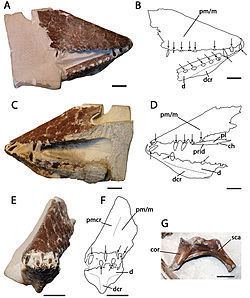Class Reptilia Rank Genus | Phylum Chordata Family †Lonchodraconidae | |
 | ||
Similar Camposipterus, Cimoliopterus, Lonchodectes, Cretornis, Longchengpterus | ||
Lonchodraco is a genus of pterodactyloid pterosaur from the Cretaceous of England. The genus includes species that were previously assigned to other genera.
Contents
Discovery and naming
In 1846, James Scott Bowerbank named and described some remains found in a chalk pit at Burham near Maidstone in Kent, as a new species of Pterodactylus: Pterodactylus giganteus. The specific name means "the gigantic one" in Latin. The same pit generated remains of Pterodactylus cuvieri. In 1848 Bowerbank published a histological study of the bone structure of P. giganteus.
At the time, the British Association Code of 1843 allowed to change names if they were inappropriate. In 1850, Richard Owen, considering the species not to have been particularly large, renamed it into Pterodactylus conirostris, "the cone-snouted", based on a conical snout, today part of specimen NHMUK PV 39412. However, after insistent objections by Bowerbank, Owen retracted this name in 1851, when he described the finds in more detail.
In 1914 Reginald Walter Hooley assigned the species to a new genus Lonchodectes, "the lance biter", as a Lonchodectes giganteus. In 2013, Taissa Rodrigues and Alexander Wilhelm Armin Kellner concluded that the type species of Lonchodectes, Lonchodectes compressirostris, was a nomen dubium. Therefore they created a new genus Lonchodraco, combining Greek λόγχη, lonchē, "lance", with Latin draco, "dragon". Pterodactylus giganteus was made the type species of Lonchodraco, resulting in a Lonchodraco giganteus. Two other species previously assigned to Lonchodectes were moved to the new genus, resulting in a Lonchodraco machaerorhynchus and a Lonchodraco(?) microdon. The question mark in the latter name indicates that the authors were uncertain about the correctness of the assignment.
Rodrigues and Kellner considered NHMUK PV 39412 to be the lectotype of Lonchodraco giganteus, after a choice by Peter Wellnhofer in 1978. It was found in a layer of the Chalk Formation, dating from the Cenomanian-Turonian. It consists of the front of a snout, the front of a pair of lower jaws, a piece of a scapulocoracoid, the upper parts of a humerus and an ulna, and a part of a wing finger phalanx.
In 1869, Harry Govier Seeley named Ptenodactylus machaerorhynchus, at the same time disclaiming the name which makes it invalid by modern standards. In 1870, Seeley had realised that the generic name Ptenodactylus had been preoccupied and renamed the species into Ornithocheirus machaerorhynchus. The specific name means "sabre snout" in Greek. In 1914 Hooley renamed it into Lonchodectes machae[r]orhynchus. Its holotype, CAMSM B54855, was near Cambridge found in a layer of the Cambridge Greensand dating from the Cenomanian but containing reworked fossils from the Albian. It consists of the rear end of a symphysis of the lower jaws.
Also in 1869, Seeley named a Ptenodactylus microdon. In 1870, he renamed it into Ornithocheirus microdon, "small tooth", in 1914 by Hooley made a Lonchodectes microdon. Its holotype, CAMSM B54486, has its provenance in the Cambridge Greensand and consists of the front of a snout. The type specimen of Ornithocheirus oweni Seeley 1870, CAMSM B 54439, was referred to Lonchodraco(?) microdon in the same study that named Lonchodraco, following a conclusion by David Unwin in 2001, and this species would then be a junior synonym.
Lonchodraco as a clade
Rodrigues & Kellner treated Lonchodraco as a clade, which thus could possess synapomorphies, shared derived traits, setting the clade apart from related groups. They established one of these: the tooth sockets are elevated relative to the palate and lower jaw edge. Also a unique combination of themselves not unique traits was present. The tooth sockets in the front of the jaws are small, with a diameter of no more than four millimetres. These sockets do not vary significantly in size. The distance between the tooth sockets about equals their diameter. The midline ridge on the palate is high. A crest is present below the lower jaws.
Each of the species of Lonchodraco has its own unique derived traits, autapomorphies, and sometimes a unique combination of traits.
Lonchodraco giganteus
Bowerbank estimated P. giganteus had a wingspan of about eight to nine feet.
Rodrigues & Kellner established two autapomorphies of Lonchodraco giganteus. Below the front of the lower jaws a short blade-like crest is present. There is a density of about six tooth sockets per three centimetres of jaw edge. There is a unique combination of traits: the snout bears a crest; the front part of the snout is rounded; the front part of the lower jaws is rounded; the margins of the front tooth sockets diverge.
Lonchodraco machaerorhynchus
Rodrigues & Kellner established four autapomorphies of Lonchodraco machaerorhynchus. A deep crest is present at the underside of the lower jaws. To the rear, the profile of this crest turns upwards. Behind this crest a depression is present at the underside of the jaws. The midline groove at the top of the lower jaws symphysis is deep. Furthermore, there is a density of 4.5 teeth per three centimetres of jaw edge.
Lonchodraco(?) microdon
Rodrigues & Kellner established two autapomorphies of Lonchodraco(?) microdon. A high ridge is present on the midline of the palate. The distance between the tooth sockets exceeds their diameter. There is a unique combination of traits: there is no crest on the snout; the profile of the snout tip is rounded; the palate is convex between the midline ridge and the jaw edges; there is a density of 4.5 teeth per three centimetres of jaw edge.
Phylogeny
Rodrigues & Kellner in 2013 assigned Lonchodraco to a family Lonchodraconidae, which was not defined as a clade and of which Lonchodraco was the only member. In cladistic analyses the three Lonchodraco species formed a cluster, but it proved impossible to obtain a precise position for it because their inclusion in the dataset made the tree largely collapse into a polytomy containing, apart from the three species, all Pterodactyloidea and even the Rhamphorhynchidae.
